Criminal Law: Comparative Penal Policy - A Comprehensive Report
VerifiedAdded on 2022/11/29
|22
|5852
|332
Report
AI Summary
This report delves into the realm of criminal law, focusing on a comparative analysis of penal policies, particularly within the United States. It examines the dramatic increase in imprisonment rates from the 1920s to the present, exploring the underlying causes and societal consequences. The report reviews various studies and findings, including the impact of imprisonment on crime reduction, the role of social and economic factors, and the disparities in incarceration rates among different demographic groups. It also addresses the effects of high imprisonment rates on communities, the health of inmates, and the challenges posed by overcrowding in prisons. The report emphasizes the complexities of penal policy, highlighting the interplay between normative commitments, empirical findings, and issues of fairness, justice, and jurisprudence. The analysis covers the evolution of penal policy, examining the interplay of factors that shape it, and the impact of this policy on society.
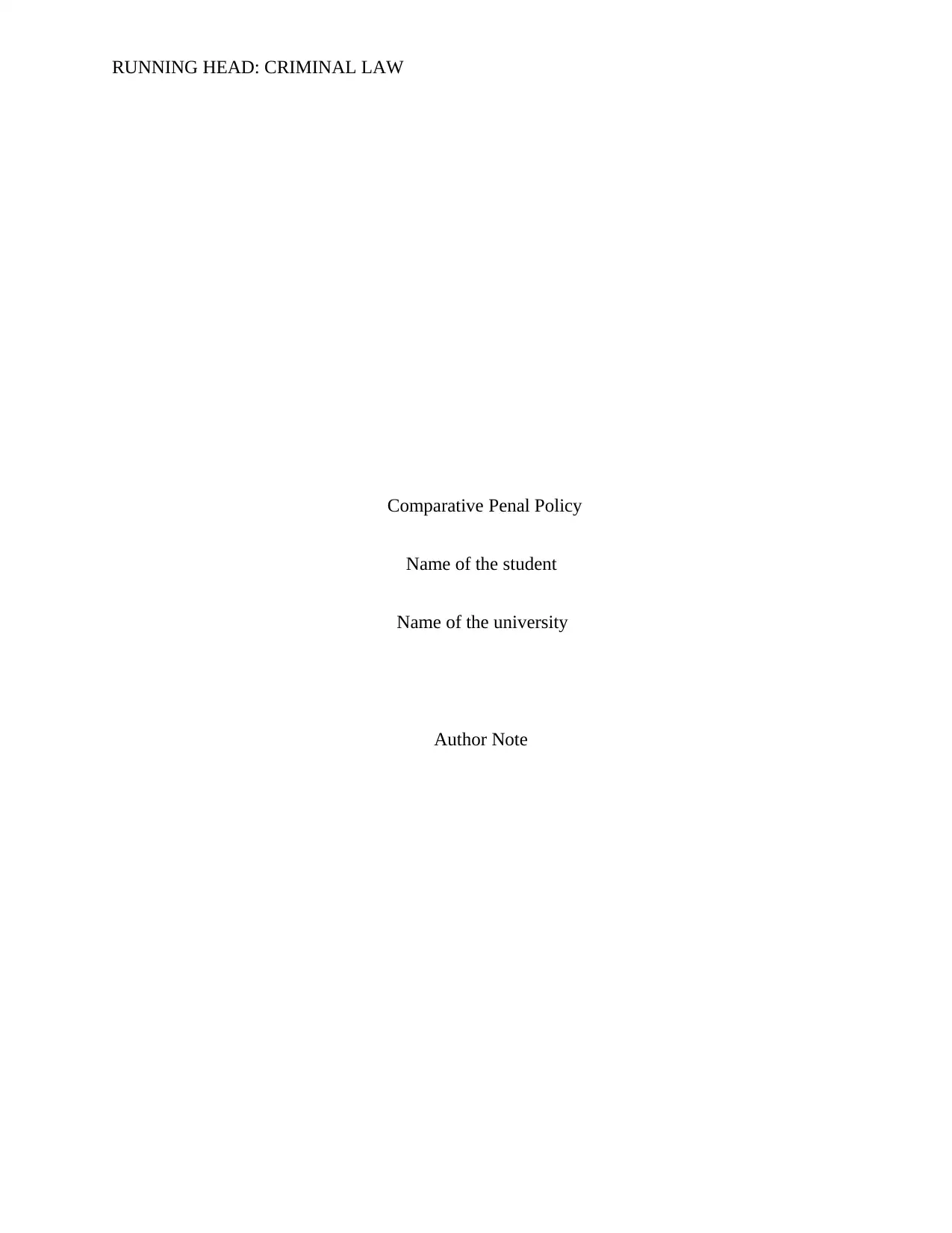
RUNNING HEAD: CRIMINAL LAW
Comparative Penal Policy
Name of the student
Name of the university
Author Note
Comparative Penal Policy
Name of the student
Name of the university
Author Note
Paraphrase This Document
Need a fresh take? Get an instant paraphrase of this document with our AI Paraphraser
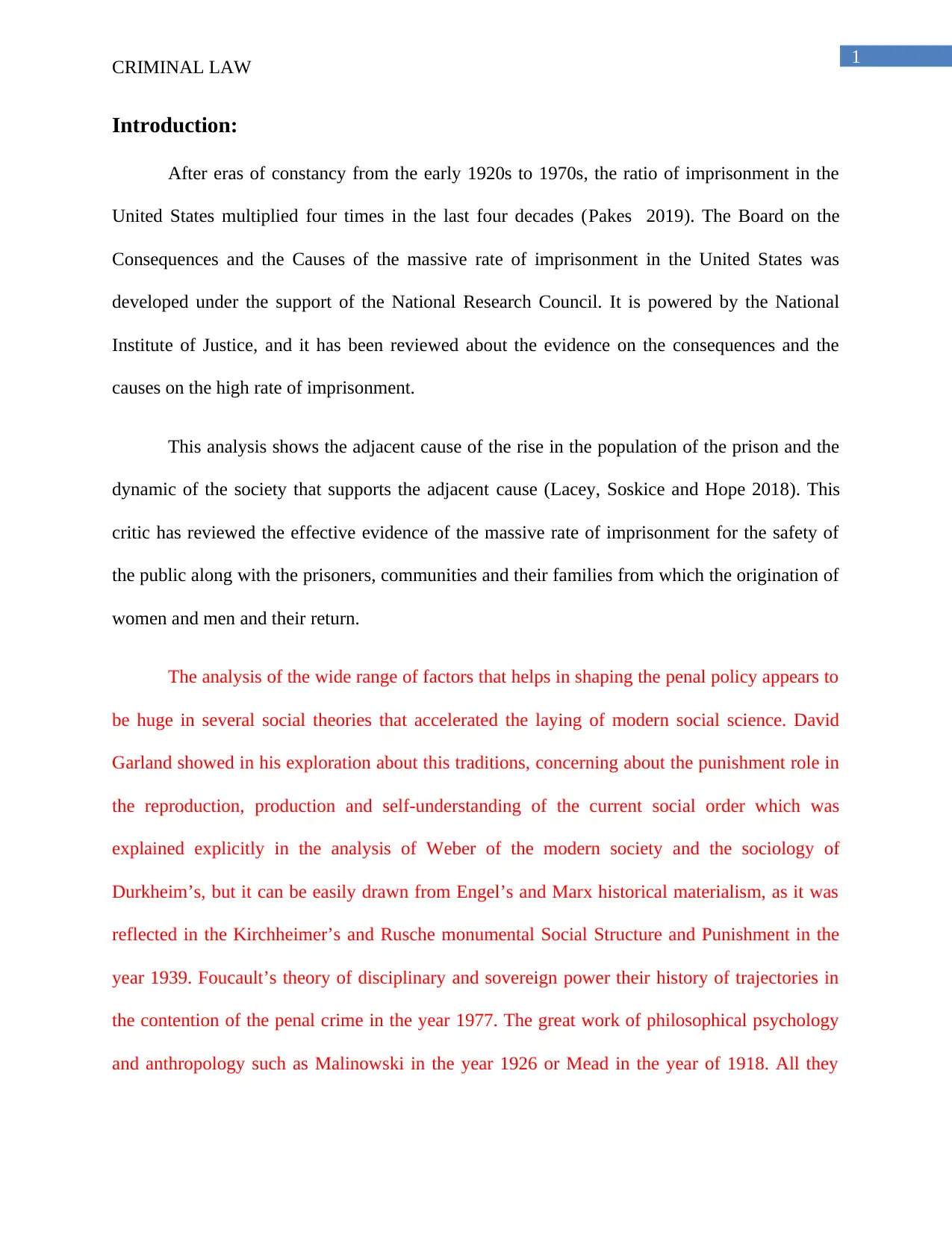
1
CRIMINAL LAW
Introduction:
After eras of constancy from the early 1920s to 1970s, the ratio of imprisonment in the
United States multiplied four times in the last four decades (Pakes 2019). The Board on the
Consequences and the Causes of the massive rate of imprisonment in the United States was
developed under the support of the National Research Council. It is powered by the National
Institute of Justice, and it has been reviewed about the evidence on the consequences and the
causes on the high rate of imprisonment.
This analysis shows the adjacent cause of the rise in the population of the prison and the
dynamic of the society that supports the adjacent cause (Lacey, Soskice and Hope 2018). This
critic has reviewed the effective evidence of the massive rate of imprisonment for the safety of
the public along with the prisoners, communities and their families from which the origination of
women and men and their return.
The analysis of the wide range of factors that helps in shaping the penal policy appears to
be huge in several social theories that accelerated the laying of modern social science. David
Garland showed in his exploration about this traditions, concerning about the punishment role in
the reproduction, production and self-understanding of the current social order which was
explained explicitly in the analysis of Weber of the modern society and the sociology of
Durkheim’s, but it can be easily drawn from Engel’s and Marx historical materialism, as it was
reflected in the Kirchheimer’s and Rusche monumental Social Structure and Punishment in the
year 1939. Foucault’s theory of disciplinary and sovereign power their history of trajectories in
the contention of the penal crime in the year 1977. The great work of philosophical psychology
and anthropology such as Malinowski in the year 1926 or Mead in the year of 1918. All they
CRIMINAL LAW
Introduction:
After eras of constancy from the early 1920s to 1970s, the ratio of imprisonment in the
United States multiplied four times in the last four decades (Pakes 2019). The Board on the
Consequences and the Causes of the massive rate of imprisonment in the United States was
developed under the support of the National Research Council. It is powered by the National
Institute of Justice, and it has been reviewed about the evidence on the consequences and the
causes on the high rate of imprisonment.
This analysis shows the adjacent cause of the rise in the population of the prison and the
dynamic of the society that supports the adjacent cause (Lacey, Soskice and Hope 2018). This
critic has reviewed the effective evidence of the massive rate of imprisonment for the safety of
the public along with the prisoners, communities and their families from which the origination of
women and men and their return.
The analysis of the wide range of factors that helps in shaping the penal policy appears to
be huge in several social theories that accelerated the laying of modern social science. David
Garland showed in his exploration about this traditions, concerning about the punishment role in
the reproduction, production and self-understanding of the current social order which was
explained explicitly in the analysis of Weber of the modern society and the sociology of
Durkheim’s, but it can be easily drawn from Engel’s and Marx historical materialism, as it was
reflected in the Kirchheimer’s and Rusche monumental Social Structure and Punishment in the
year 1939. Foucault’s theory of disciplinary and sovereign power their history of trajectories in
the contention of the penal crime in the year 1977. The great work of philosophical psychology
and anthropology such as Malinowski in the year 1926 or Mead in the year of 1918. All they
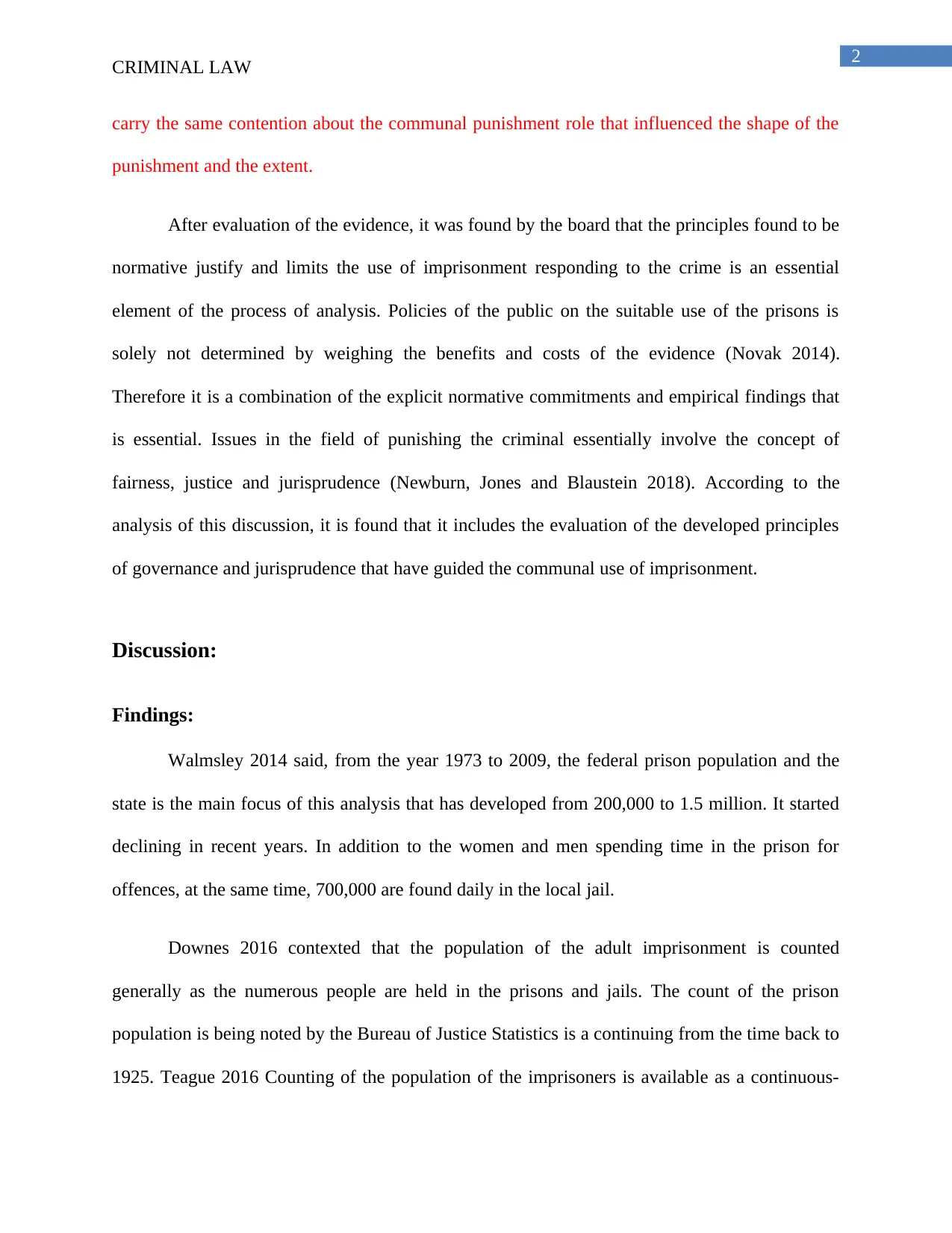
2
CRIMINAL LAW
carry the same contention about the communal punishment role that influenced the shape of the
punishment and the extent.
After evaluation of the evidence, it was found by the board that the principles found to be
normative justify and limits the use of imprisonment responding to the crime is an essential
element of the process of analysis. Policies of the public on the suitable use of the prisons is
solely not determined by weighing the benefits and costs of the evidence (Novak 2014).
Therefore it is a combination of the explicit normative commitments and empirical findings that
is essential. Issues in the field of punishing the criminal essentially involve the concept of
fairness, justice and jurisprudence (Newburn, Jones and Blaustein 2018). According to the
analysis of this discussion, it is found that it includes the evaluation of the developed principles
of governance and jurisprudence that have guided the communal use of imprisonment.
Discussion:
Findings:
Walmsley 2014 said, from the year 1973 to 2009, the federal prison population and the
state is the main focus of this analysis that has developed from 200,000 to 1.5 million. It started
declining in recent years. In addition to the women and men spending time in the prison for
offences, at the same time, 700,000 are found daily in the local jail.
Downes 2016 contexted that the population of the adult imprisonment is counted
generally as the numerous people are held in the prisons and jails. The count of the prison
population is being noted by the Bureau of Justice Statistics is a continuing from the time back to
1925. Teague 2016 Counting of the population of the imprisoners is available as a continuous-
CRIMINAL LAW
carry the same contention about the communal punishment role that influenced the shape of the
punishment and the extent.
After evaluation of the evidence, it was found by the board that the principles found to be
normative justify and limits the use of imprisonment responding to the crime is an essential
element of the process of analysis. Policies of the public on the suitable use of the prisons is
solely not determined by weighing the benefits and costs of the evidence (Novak 2014).
Therefore it is a combination of the explicit normative commitments and empirical findings that
is essential. Issues in the field of punishing the criminal essentially involve the concept of
fairness, justice and jurisprudence (Newburn, Jones and Blaustein 2018). According to the
analysis of this discussion, it is found that it includes the evaluation of the developed principles
of governance and jurisprudence that have guided the communal use of imprisonment.
Discussion:
Findings:
Walmsley 2014 said, from the year 1973 to 2009, the federal prison population and the
state is the main focus of this analysis that has developed from 200,000 to 1.5 million. It started
declining in recent years. In addition to the women and men spending time in the prison for
offences, at the same time, 700,000 are found daily in the local jail.
Downes 2016 contexted that the population of the adult imprisonment is counted
generally as the numerous people are held in the prisons and jails. The count of the prison
population is being noted by the Bureau of Justice Statistics is a continuing from the time back to
1925. Teague 2016 Counting of the population of the imprisoners is available as a continuous-
⊘ This is a preview!⊘
Do you want full access?
Subscribe today to unlock all pages.

Trusted by 1+ million students worldwide
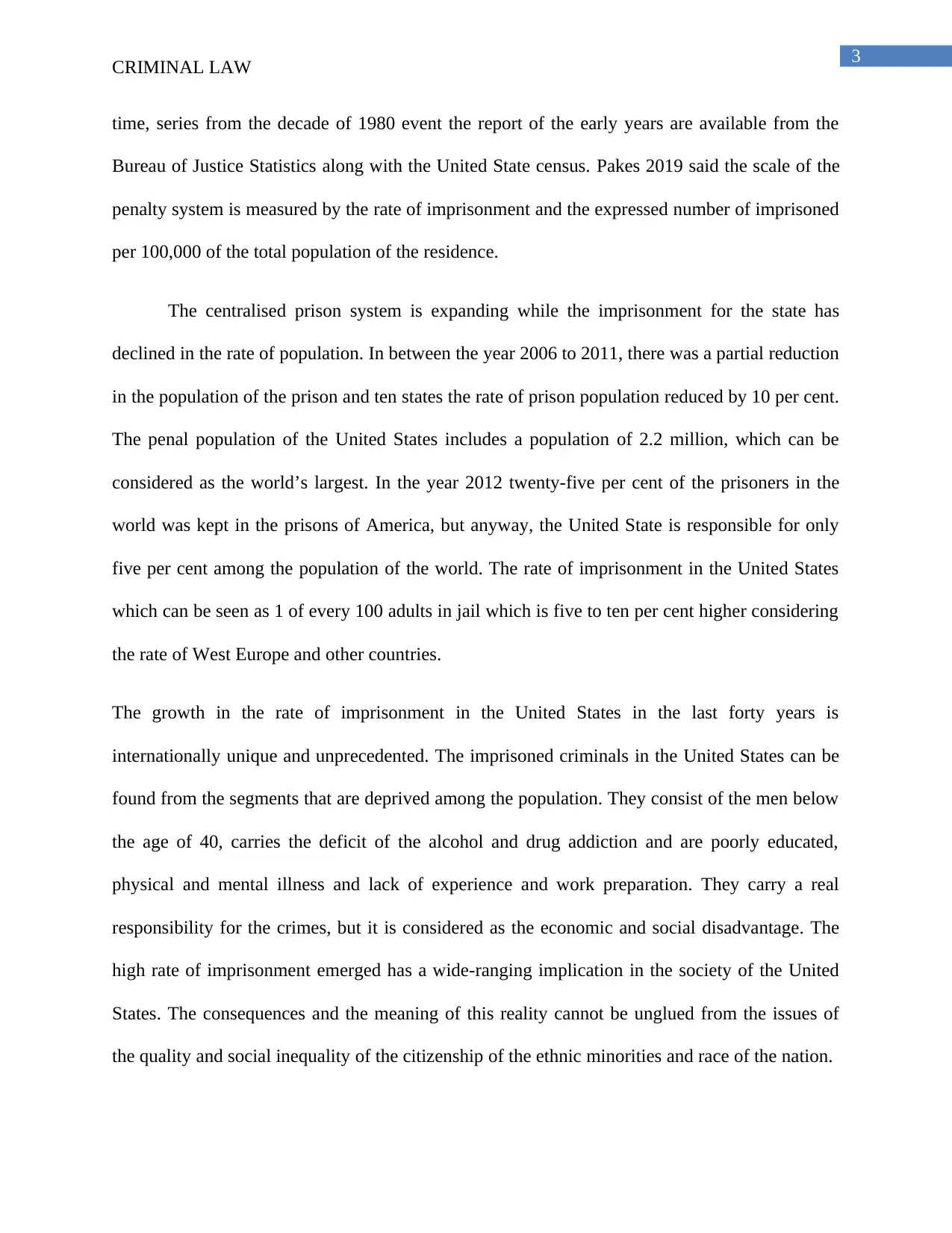
3
CRIMINAL LAW
time, series from the decade of 1980 event the report of the early years are available from the
Bureau of Justice Statistics along with the United State census. Pakes 2019 said the scale of the
penalty system is measured by the rate of imprisonment and the expressed number of imprisoned
per 100,000 of the total population of the residence.
The centralised prison system is expanding while the imprisonment for the state has
declined in the rate of population. In between the year 2006 to 2011, there was a partial reduction
in the population of the prison and ten states the rate of prison population reduced by 10 per cent.
The penal population of the United States includes a population of 2.2 million, which can be
considered as the world’s largest. In the year 2012 twenty-five per cent of the prisoners in the
world was kept in the prisons of America, but anyway, the United State is responsible for only
five per cent among the population of the world. The rate of imprisonment in the United States
which can be seen as 1 of every 100 adults in jail which is five to ten per cent higher considering
the rate of West Europe and other countries.
The growth in the rate of imprisonment in the United States in the last forty years is
internationally unique and unprecedented. The imprisoned criminals in the United States can be
found from the segments that are deprived among the population. They consist of the men below
the age of 40, carries the deficit of the alcohol and drug addiction and are poorly educated,
physical and mental illness and lack of experience and work preparation. They carry a real
responsibility for the crimes, but it is considered as the economic and social disadvantage. The
high rate of imprisonment emerged has a wide-ranging implication in the society of the United
States. The consequences and the meaning of this reality cannot be unglued from the issues of
the quality and social inequality of the citizenship of the ethnic minorities and race of the nation.
CRIMINAL LAW
time, series from the decade of 1980 event the report of the early years are available from the
Bureau of Justice Statistics along with the United State census. Pakes 2019 said the scale of the
penalty system is measured by the rate of imprisonment and the expressed number of imprisoned
per 100,000 of the total population of the residence.
The centralised prison system is expanding while the imprisonment for the state has
declined in the rate of population. In between the year 2006 to 2011, there was a partial reduction
in the population of the prison and ten states the rate of prison population reduced by 10 per cent.
The penal population of the United States includes a population of 2.2 million, which can be
considered as the world’s largest. In the year 2012 twenty-five per cent of the prisoners in the
world was kept in the prisons of America, but anyway, the United State is responsible for only
five per cent among the population of the world. The rate of imprisonment in the United States
which can be seen as 1 of every 100 adults in jail which is five to ten per cent higher considering
the rate of West Europe and other countries.
The growth in the rate of imprisonment in the United States in the last forty years is
internationally unique and unprecedented. The imprisoned criminals in the United States can be
found from the segments that are deprived among the population. They consist of the men below
the age of 40, carries the deficit of the alcohol and drug addiction and are poorly educated,
physical and mental illness and lack of experience and work preparation. They carry a real
responsibility for the crimes, but it is considered as the economic and social disadvantage. The
high rate of imprisonment emerged has a wide-ranging implication in the society of the United
States. The consequences and the meaning of this reality cannot be unglued from the issues of
the quality and social inequality of the citizenship of the ethnic minorities and race of the nation.
Paraphrase This Document
Need a fresh take? Get an instant paraphrase of this document with our AI Paraphraser
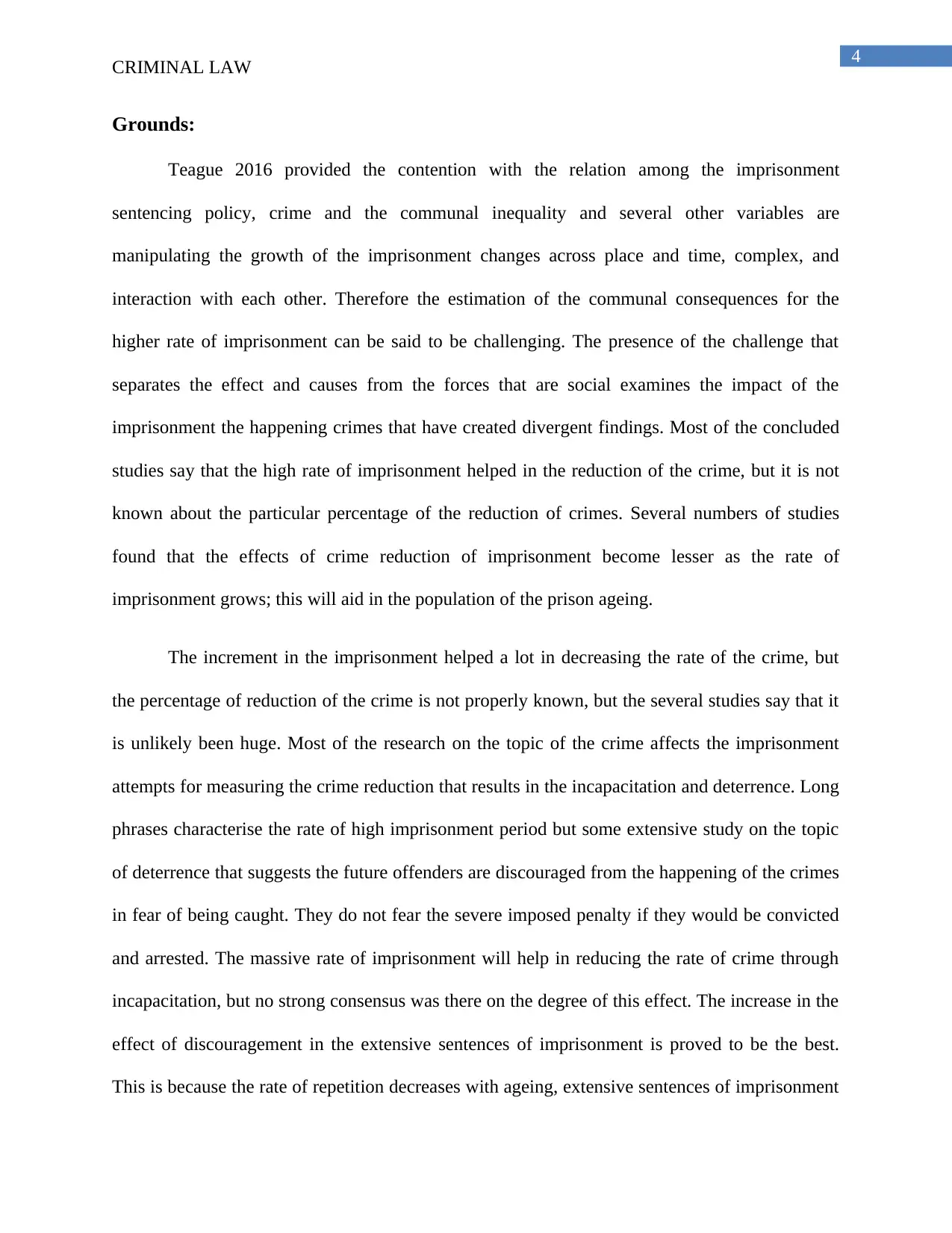
4
CRIMINAL LAW
Grounds:
Teague 2016 provided the contention with the relation among the imprisonment
sentencing policy, crime and the communal inequality and several other variables are
manipulating the growth of the imprisonment changes across place and time, complex, and
interaction with each other. Therefore the estimation of the communal consequences for the
higher rate of imprisonment can be said to be challenging. The presence of the challenge that
separates the effect and causes from the forces that are social examines the impact of the
imprisonment the happening crimes that have created divergent findings. Most of the concluded
studies say that the high rate of imprisonment helped in the reduction of the crime, but it is not
known about the particular percentage of the reduction of crimes. Several numbers of studies
found that the effects of crime reduction of imprisonment become lesser as the rate of
imprisonment grows; this will aid in the population of the prison ageing.
The increment in the imprisonment helped a lot in decreasing the rate of the crime, but
the percentage of reduction of the crime is not properly known, but the several studies say that it
is unlikely been huge. Most of the research on the topic of the crime affects the imprisonment
attempts for measuring the crime reduction that results in the incapacitation and deterrence. Long
phrases characterise the rate of high imprisonment period but some extensive study on the topic
of deterrence that suggests the future offenders are discouraged from the happening of the crimes
in fear of being caught. They do not fear the severe imposed penalty if they would be convicted
and arrested. The massive rate of imprisonment will help in reducing the rate of crime through
incapacitation, but no strong consensus was there on the degree of this effect. The increase in the
effect of discouragement in the extensive sentences of imprisonment is proved to be the best.
This is because the rate of repetition decreases with ageing, extensive sentences of imprisonment
CRIMINAL LAW
Grounds:
Teague 2016 provided the contention with the relation among the imprisonment
sentencing policy, crime and the communal inequality and several other variables are
manipulating the growth of the imprisonment changes across place and time, complex, and
interaction with each other. Therefore the estimation of the communal consequences for the
higher rate of imprisonment can be said to be challenging. The presence of the challenge that
separates the effect and causes from the forces that are social examines the impact of the
imprisonment the happening crimes that have created divergent findings. Most of the concluded
studies say that the high rate of imprisonment helped in the reduction of the crime, but it is not
known about the particular percentage of the reduction of crimes. Several numbers of studies
found that the effects of crime reduction of imprisonment become lesser as the rate of
imprisonment grows; this will aid in the population of the prison ageing.
The increment in the imprisonment helped a lot in decreasing the rate of the crime, but
the percentage of reduction of the crime is not properly known, but the several studies say that it
is unlikely been huge. Most of the research on the topic of the crime affects the imprisonment
attempts for measuring the crime reduction that results in the incapacitation and deterrence. Long
phrases characterise the rate of high imprisonment period but some extensive study on the topic
of deterrence that suggests the future offenders are discouraged from the happening of the crimes
in fear of being caught. They do not fear the severe imposed penalty if they would be convicted
and arrested. The massive rate of imprisonment will help in reducing the rate of crime through
incapacitation, but no strong consensus was there on the degree of this effect. The increase in the
effect of discouragement in the extensive sentences of imprisonment is proved to be the best.
This is because the rate of repetition decreases with ageing, extensive sentences of imprisonment
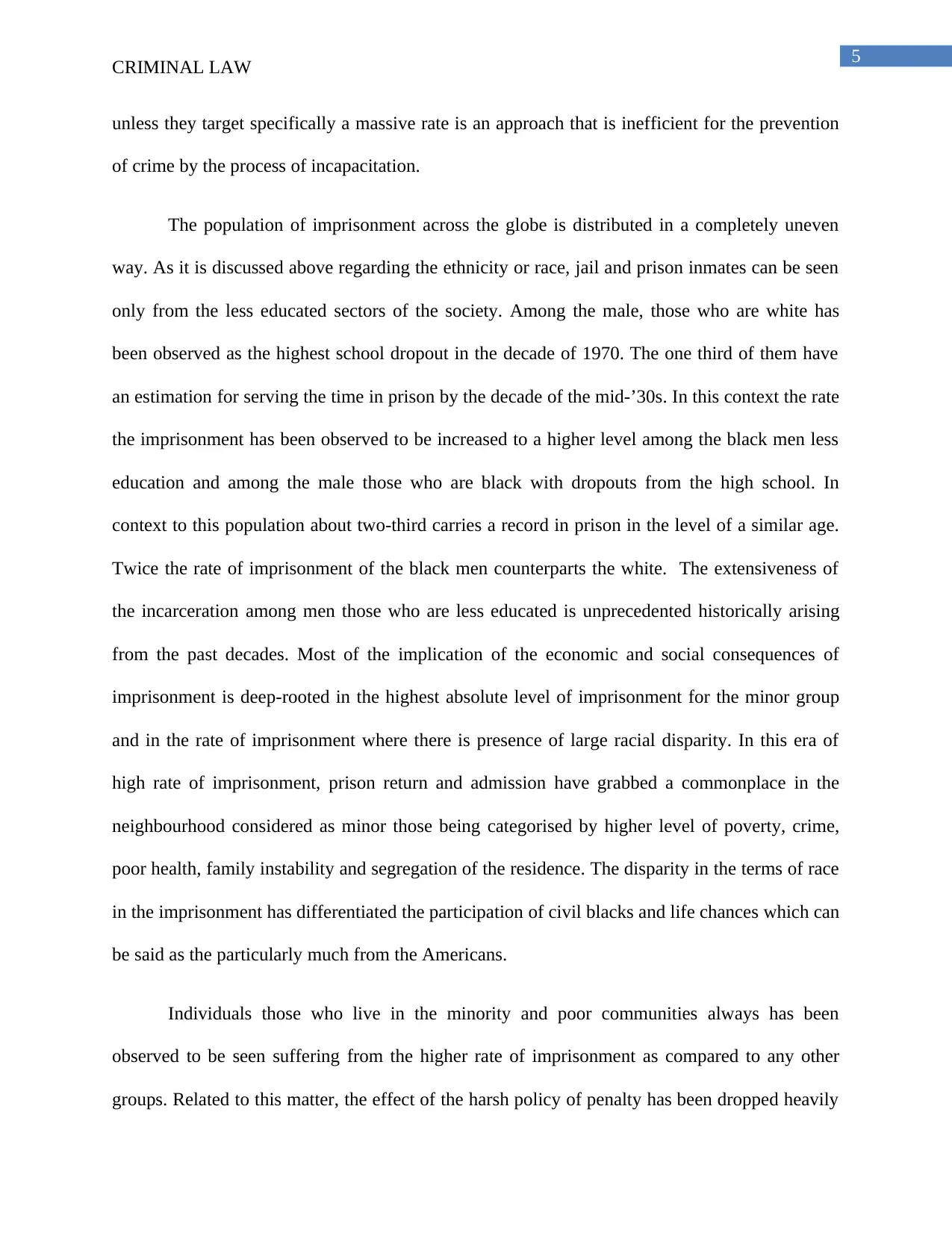
5
CRIMINAL LAW
unless they target specifically a massive rate is an approach that is inefficient for the prevention
of crime by the process of incapacitation.
The population of imprisonment across the globe is distributed in a completely uneven
way. As it is discussed above regarding the ethnicity or race, jail and prison inmates can be seen
only from the less educated sectors of the society. Among the male, those who are white has
been observed as the highest school dropout in the decade of 1970. The one third of them have
an estimation for serving the time in prison by the decade of the mid-’30s. In this context the rate
the imprisonment has been observed to be increased to a higher level among the black men less
education and among the male those who are black with dropouts from the high school. In
context to this population about two-third carries a record in prison in the level of a similar age.
Twice the rate of imprisonment of the black men counterparts the white. The extensiveness of
the incarceration among men those who are less educated is unprecedented historically arising
from the past decades. Most of the implication of the economic and social consequences of
imprisonment is deep-rooted in the highest absolute level of imprisonment for the minor group
and in the rate of imprisonment where there is presence of large racial disparity. In this era of
high rate of imprisonment, prison return and admission have grabbed a commonplace in the
neighbourhood considered as minor those being categorised by higher level of poverty, crime,
poor health, family instability and segregation of the residence. The disparity in the terms of race
in the imprisonment has differentiated the participation of civil blacks and life chances which can
be said as the particularly much from the Americans.
Individuals those who live in the minority and poor communities always has been
observed to be seen suffering from the higher rate of imprisonment as compared to any other
groups. Related to this matter, the effect of the harsh policy of penalty has been dropped heavily
CRIMINAL LAW
unless they target specifically a massive rate is an approach that is inefficient for the prevention
of crime by the process of incapacitation.
The population of imprisonment across the globe is distributed in a completely uneven
way. As it is discussed above regarding the ethnicity or race, jail and prison inmates can be seen
only from the less educated sectors of the society. Among the male, those who are white has
been observed as the highest school dropout in the decade of 1970. The one third of them have
an estimation for serving the time in prison by the decade of the mid-’30s. In this context the rate
the imprisonment has been observed to be increased to a higher level among the black men less
education and among the male those who are black with dropouts from the high school. In
context to this population about two-third carries a record in prison in the level of a similar age.
Twice the rate of imprisonment of the black men counterparts the white. The extensiveness of
the incarceration among men those who are less educated is unprecedented historically arising
from the past decades. Most of the implication of the economic and social consequences of
imprisonment is deep-rooted in the highest absolute level of imprisonment for the minor group
and in the rate of imprisonment where there is presence of large racial disparity. In this era of
high rate of imprisonment, prison return and admission have grabbed a commonplace in the
neighbourhood considered as minor those being categorised by higher level of poverty, crime,
poor health, family instability and segregation of the residence. The disparity in the terms of race
in the imprisonment has differentiated the participation of civil blacks and life chances which can
be said as the particularly much from the Americans.
Individuals those who live in the minority and poor communities always has been
observed to be seen suffering from the higher rate of imprisonment as compared to any other
groups. Related to this matter, the effect of the harsh policy of penalty has been dropped heavily
⊘ This is a preview!⊘
Do you want full access?
Subscribe today to unlock all pages.

Trusted by 1+ million students worldwide
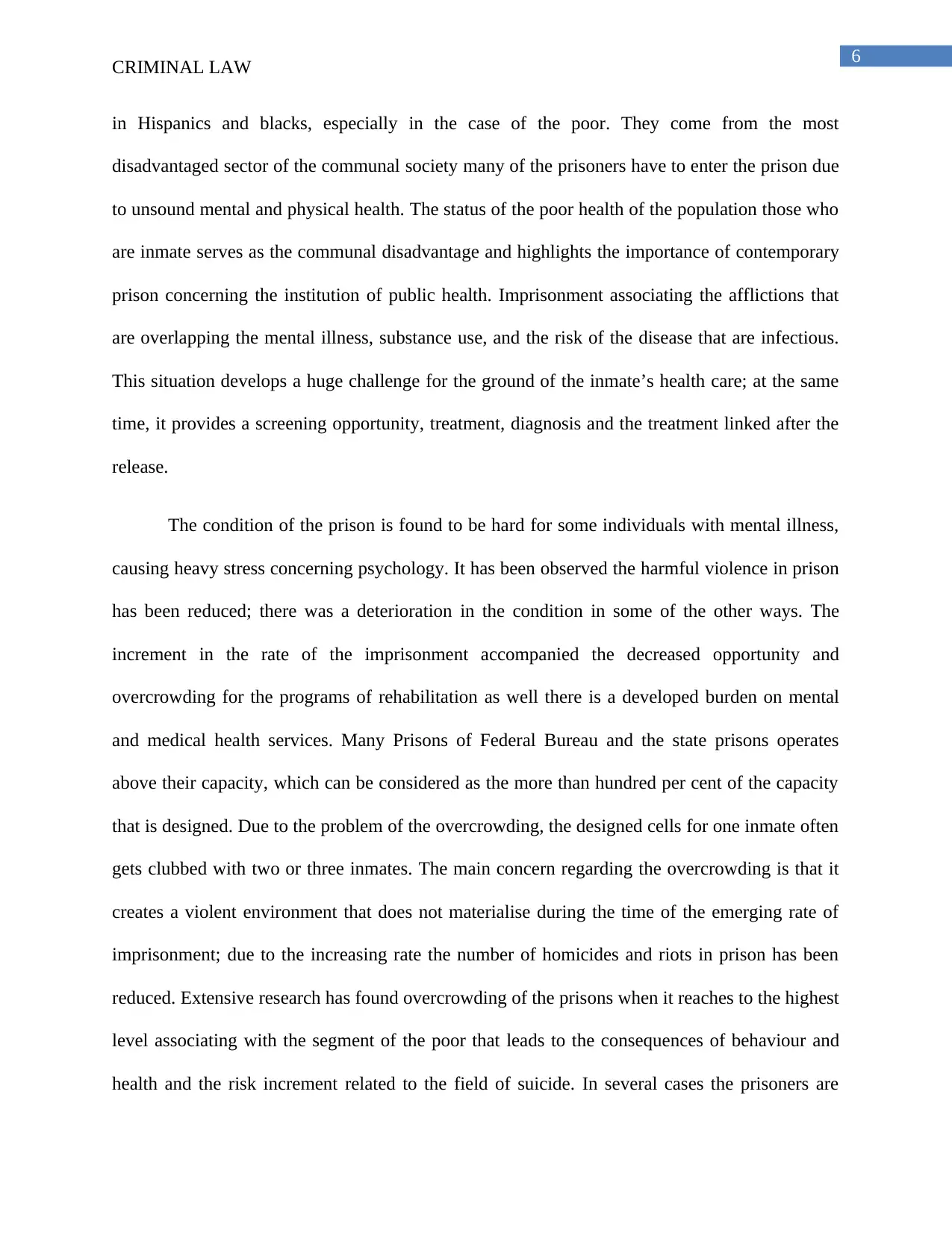
6
CRIMINAL LAW
in Hispanics and blacks, especially in the case of the poor. They come from the most
disadvantaged sector of the communal society many of the prisoners have to enter the prison due
to unsound mental and physical health. The status of the poor health of the population those who
are inmate serves as the communal disadvantage and highlights the importance of contemporary
prison concerning the institution of public health. Imprisonment associating the afflictions that
are overlapping the mental illness, substance use, and the risk of the disease that are infectious.
This situation develops a huge challenge for the ground of the inmate’s health care; at the same
time, it provides a screening opportunity, treatment, diagnosis and the treatment linked after the
release.
The condition of the prison is found to be hard for some individuals with mental illness,
causing heavy stress concerning psychology. It has been observed the harmful violence in prison
has been reduced; there was a deterioration in the condition in some of the other ways. The
increment in the rate of the imprisonment accompanied the decreased opportunity and
overcrowding for the programs of rehabilitation as well there is a developed burden on mental
and medical health services. Many Prisons of Federal Bureau and the state prisons operates
above their capacity, which can be considered as the more than hundred per cent of the capacity
that is designed. Due to the problem of the overcrowding, the designed cells for one inmate often
gets clubbed with two or three inmates. The main concern regarding the overcrowding is that it
creates a violent environment that does not materialise during the time of the emerging rate of
imprisonment; due to the increasing rate the number of homicides and riots in prison has been
reduced. Extensive research has found overcrowding of the prisons when it reaches to the highest
level associating with the segment of the poor that leads to the consequences of behaviour and
health and the risk increment related to the field of suicide. In several cases the prisoners are
CRIMINAL LAW
in Hispanics and blacks, especially in the case of the poor. They come from the most
disadvantaged sector of the communal society many of the prisoners have to enter the prison due
to unsound mental and physical health. The status of the poor health of the population those who
are inmate serves as the communal disadvantage and highlights the importance of contemporary
prison concerning the institution of public health. Imprisonment associating the afflictions that
are overlapping the mental illness, substance use, and the risk of the disease that are infectious.
This situation develops a huge challenge for the ground of the inmate’s health care; at the same
time, it provides a screening opportunity, treatment, diagnosis and the treatment linked after the
release.
The condition of the prison is found to be hard for some individuals with mental illness,
causing heavy stress concerning psychology. It has been observed the harmful violence in prison
has been reduced; there was a deterioration in the condition in some of the other ways. The
increment in the rate of the imprisonment accompanied the decreased opportunity and
overcrowding for the programs of rehabilitation as well there is a developed burden on mental
and medical health services. Many Prisons of Federal Bureau and the state prisons operates
above their capacity, which can be considered as the more than hundred per cent of the capacity
that is designed. Due to the problem of the overcrowding, the designed cells for one inmate often
gets clubbed with two or three inmates. The main concern regarding the overcrowding is that it
creates a violent environment that does not materialise during the time of the emerging rate of
imprisonment; due to the increasing rate the number of homicides and riots in prison has been
reduced. Extensive research has found overcrowding of the prisons when it reaches to the highest
level associating with the segment of the poor that leads to the consequences of behaviour and
health and the risk increment related to the field of suicide. In several cases the prisoners are
Paraphrase This Document
Need a fresh take? Get an instant paraphrase of this document with our AI Paraphraser
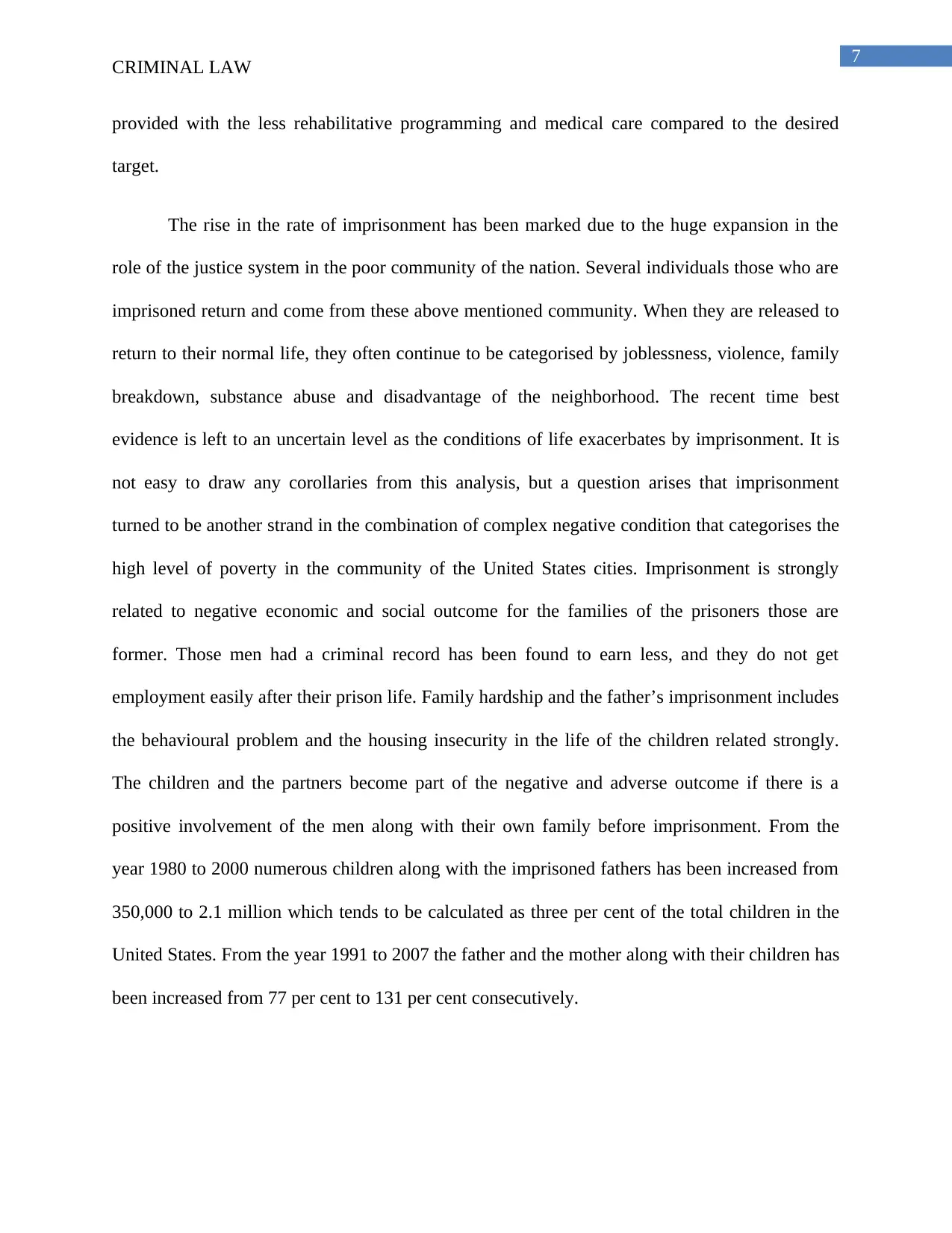
7
CRIMINAL LAW
provided with the less rehabilitative programming and medical care compared to the desired
target.
The rise in the rate of imprisonment has been marked due to the huge expansion in the
role of the justice system in the poor community of the nation. Several individuals those who are
imprisoned return and come from these above mentioned community. When they are released to
return to their normal life, they often continue to be categorised by joblessness, violence, family
breakdown, substance abuse and disadvantage of the neighborhood. The recent time best
evidence is left to an uncertain level as the conditions of life exacerbates by imprisonment. It is
not easy to draw any corollaries from this analysis, but a question arises that imprisonment
turned to be another strand in the combination of complex negative condition that categorises the
high level of poverty in the community of the United States cities. Imprisonment is strongly
related to negative economic and social outcome for the families of the prisoners those are
former. Those men had a criminal record has been found to earn less, and they do not get
employment easily after their prison life. Family hardship and the father’s imprisonment includes
the behavioural problem and the housing insecurity in the life of the children related strongly.
The children and the partners become part of the negative and adverse outcome if there is a
positive involvement of the men along with their own family before imprisonment. From the
year 1980 to 2000 numerous children along with the imprisoned fathers has been increased from
350,000 to 2.1 million which tends to be calculated as three per cent of the total children in the
United States. From the year 1991 to 2007 the father and the mother along with their children has
been increased from 77 per cent to 131 per cent consecutively.
CRIMINAL LAW
provided with the less rehabilitative programming and medical care compared to the desired
target.
The rise in the rate of imprisonment has been marked due to the huge expansion in the
role of the justice system in the poor community of the nation. Several individuals those who are
imprisoned return and come from these above mentioned community. When they are released to
return to their normal life, they often continue to be categorised by joblessness, violence, family
breakdown, substance abuse and disadvantage of the neighborhood. The recent time best
evidence is left to an uncertain level as the conditions of life exacerbates by imprisonment. It is
not easy to draw any corollaries from this analysis, but a question arises that imprisonment
turned to be another strand in the combination of complex negative condition that categorises the
high level of poverty in the community of the United States cities. Imprisonment is strongly
related to negative economic and social outcome for the families of the prisoners those are
former. Those men had a criminal record has been found to earn less, and they do not get
employment easily after their prison life. Family hardship and the father’s imprisonment includes
the behavioural problem and the housing insecurity in the life of the children related strongly.
The children and the partners become part of the negative and adverse outcome if there is a
positive involvement of the men along with their own family before imprisonment. From the
year 1980 to 2000 numerous children along with the imprisoned fathers has been increased from
350,000 to 2.1 million which tends to be calculated as three per cent of the total children in the
United States. From the year 1991 to 2007 the father and the mother along with their children has
been increased from 77 per cent to 131 per cent consecutively.
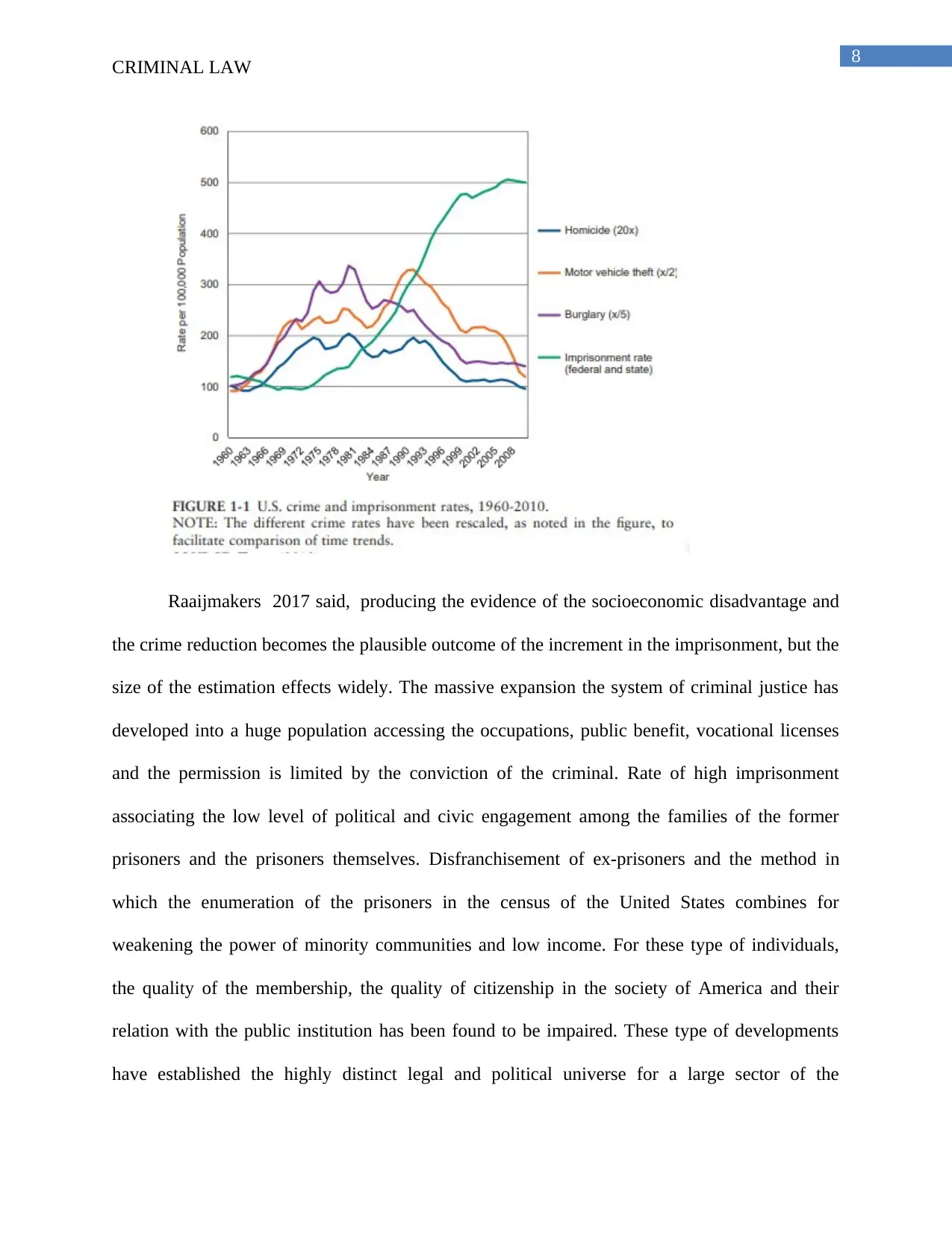
8
CRIMINAL LAW
Raaijmakers 2017 said, producing the evidence of the socioeconomic disadvantage and
the crime reduction becomes the plausible outcome of the increment in the imprisonment, but the
size of the estimation effects widely. The massive expansion the system of criminal justice has
developed into a huge population accessing the occupations, public benefit, vocational licenses
and the permission is limited by the conviction of the criminal. Rate of high imprisonment
associating the low level of political and civic engagement among the families of the former
prisoners and the prisoners themselves. Disfranchisement of ex-prisoners and the method in
which the enumeration of the prisoners in the census of the United States combines for
weakening the power of minority communities and low income. For these type of individuals,
the quality of the membership, the quality of citizenship in the society of America and their
relation with the public institution has been found to be impaired. These type of developments
have established the highly distinct legal and political universe for a large sector of the
CRIMINAL LAW
Raaijmakers 2017 said, producing the evidence of the socioeconomic disadvantage and
the crime reduction becomes the plausible outcome of the increment in the imprisonment, but the
size of the estimation effects widely. The massive expansion the system of criminal justice has
developed into a huge population accessing the occupations, public benefit, vocational licenses
and the permission is limited by the conviction of the criminal. Rate of high imprisonment
associating the low level of political and civic engagement among the families of the former
prisoners and the prisoners themselves. Disfranchisement of ex-prisoners and the method in
which the enumeration of the prisoners in the census of the United States combines for
weakening the power of minority communities and low income. For these type of individuals,
the quality of the membership, the quality of citizenship in the society of America and their
relation with the public institution has been found to be impaired. These type of developments
have established the highly distinct legal and political universe for a large sector of the
⊘ This is a preview!⊘
Do you want full access?
Subscribe today to unlock all pages.

Trusted by 1+ million students worldwide
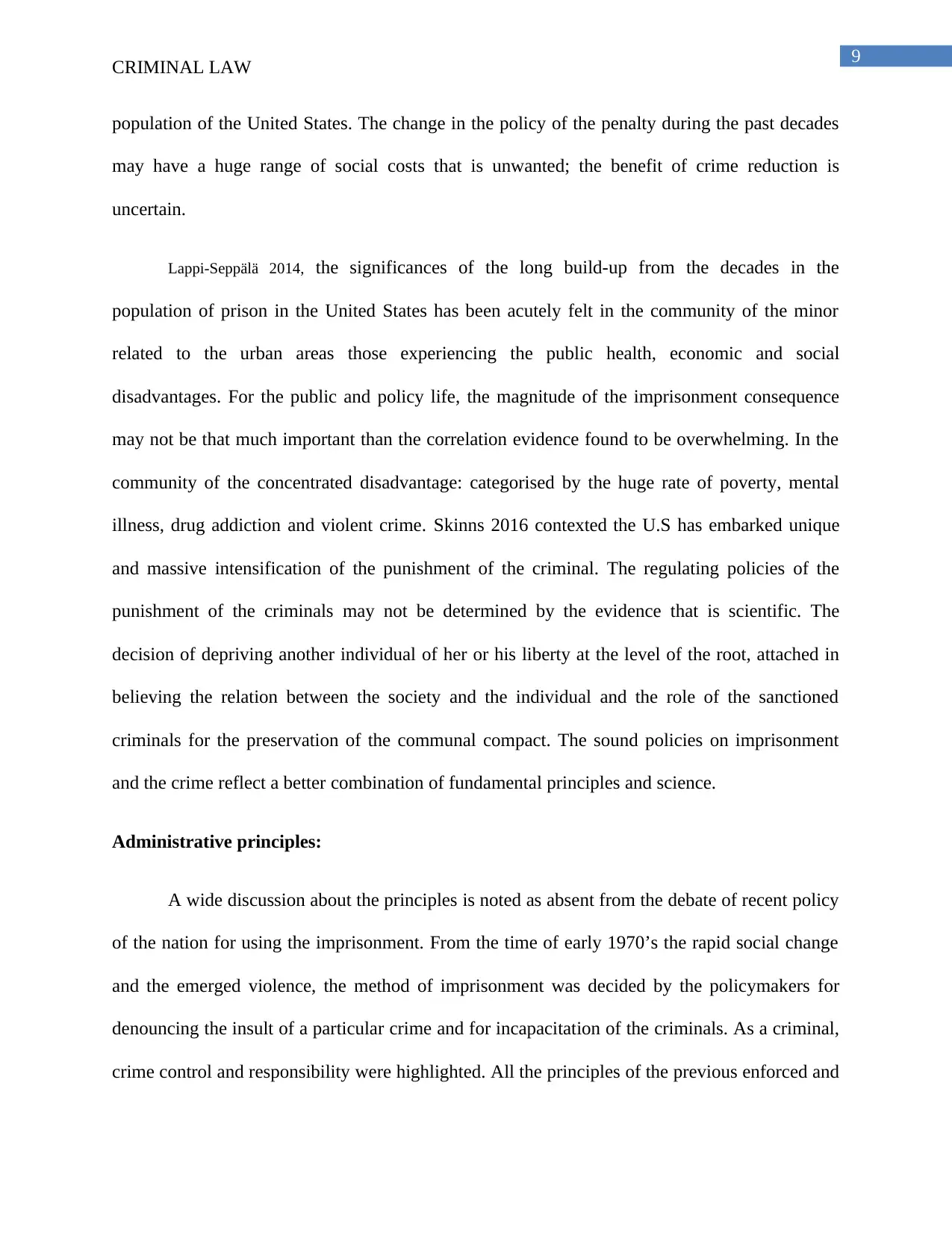
9
CRIMINAL LAW
population of the United States. The change in the policy of the penalty during the past decades
may have a huge range of social costs that is unwanted; the benefit of crime reduction is
uncertain.
Lappi-Seppälä 2014, the significances of the long build-up from the decades in the
population of prison in the United States has been acutely felt in the community of the minor
related to the urban areas those experiencing the public health, economic and social
disadvantages. For the public and policy life, the magnitude of the imprisonment consequence
may not be that much important than the correlation evidence found to be overwhelming. In the
community of the concentrated disadvantage: categorised by the huge rate of poverty, mental
illness, drug addiction and violent crime. Skinns 2016 contexted the U.S has embarked unique
and massive intensification of the punishment of the criminal. The regulating policies of the
punishment of the criminals may not be determined by the evidence that is scientific. The
decision of depriving another individual of her or his liberty at the level of the root, attached in
believing the relation between the society and the individual and the role of the sanctioned
criminals for the preservation of the communal compact. The sound policies on imprisonment
and the crime reflect a better combination of fundamental principles and science.
Administrative principles:
A wide discussion about the principles is noted as absent from the debate of recent policy
of the nation for using the imprisonment. From the time of early 1970’s the rapid social change
and the emerged violence, the method of imprisonment was decided by the policymakers for
denouncing the insult of a particular crime and for incapacitation of the criminals. As a criminal,
crime control and responsibility were highlighted. All the principles of the previous enforced and
CRIMINAL LAW
population of the United States. The change in the policy of the penalty during the past decades
may have a huge range of social costs that is unwanted; the benefit of crime reduction is
uncertain.
Lappi-Seppälä 2014, the significances of the long build-up from the decades in the
population of prison in the United States has been acutely felt in the community of the minor
related to the urban areas those experiencing the public health, economic and social
disadvantages. For the public and policy life, the magnitude of the imprisonment consequence
may not be that much important than the correlation evidence found to be overwhelming. In the
community of the concentrated disadvantage: categorised by the huge rate of poverty, mental
illness, drug addiction and violent crime. Skinns 2016 contexted the U.S has embarked unique
and massive intensification of the punishment of the criminal. The regulating policies of the
punishment of the criminals may not be determined by the evidence that is scientific. The
decision of depriving another individual of her or his liberty at the level of the root, attached in
believing the relation between the society and the individual and the role of the sanctioned
criminals for the preservation of the communal compact. The sound policies on imprisonment
and the crime reflect a better combination of fundamental principles and science.
Administrative principles:
A wide discussion about the principles is noted as absent from the debate of recent policy
of the nation for using the imprisonment. From the time of early 1970’s the rapid social change
and the emerged violence, the method of imprisonment was decided by the policymakers for
denouncing the insult of a particular crime and for incapacitation of the criminals. As a criminal,
crime control and responsibility were highlighted. All the principles of the previous enforced and
Paraphrase This Document
Need a fresh take? Get an instant paraphrase of this document with our AI Paraphraser
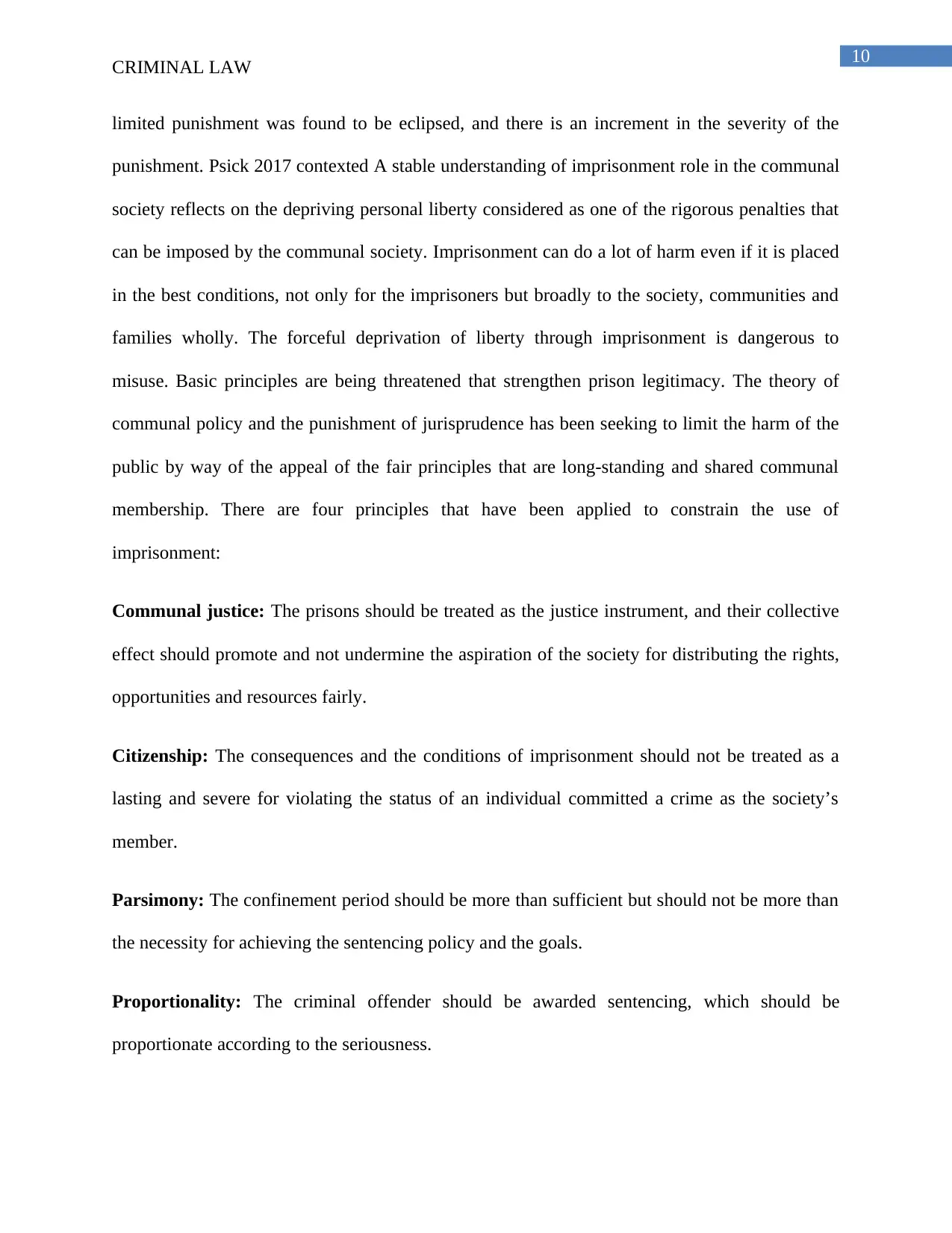
10
CRIMINAL LAW
limited punishment was found to be eclipsed, and there is an increment in the severity of the
punishment. Psick 2017 contexted A stable understanding of imprisonment role in the communal
society reflects on the depriving personal liberty considered as one of the rigorous penalties that
can be imposed by the communal society. Imprisonment can do a lot of harm even if it is placed
in the best conditions, not only for the imprisoners but broadly to the society, communities and
families wholly. The forceful deprivation of liberty through imprisonment is dangerous to
misuse. Basic principles are being threatened that strengthen prison legitimacy. The theory of
communal policy and the punishment of jurisprudence has been seeking to limit the harm of the
public by way of the appeal of the fair principles that are long-standing and shared communal
membership. There are four principles that have been applied to constrain the use of
imprisonment:
Communal justice: The prisons should be treated as the justice instrument, and their collective
effect should promote and not undermine the aspiration of the society for distributing the rights,
opportunities and resources fairly.
Citizenship: The consequences and the conditions of imprisonment should not be treated as a
lasting and severe for violating the status of an individual committed a crime as the society’s
member.
Parsimony: The confinement period should be more than sufficient but should not be more than
the necessity for achieving the sentencing policy and the goals.
Proportionality: The criminal offender should be awarded sentencing, which should be
proportionate according to the seriousness.
CRIMINAL LAW
limited punishment was found to be eclipsed, and there is an increment in the severity of the
punishment. Psick 2017 contexted A stable understanding of imprisonment role in the communal
society reflects on the depriving personal liberty considered as one of the rigorous penalties that
can be imposed by the communal society. Imprisonment can do a lot of harm even if it is placed
in the best conditions, not only for the imprisoners but broadly to the society, communities and
families wholly. The forceful deprivation of liberty through imprisonment is dangerous to
misuse. Basic principles are being threatened that strengthen prison legitimacy. The theory of
communal policy and the punishment of jurisprudence has been seeking to limit the harm of the
public by way of the appeal of the fair principles that are long-standing and shared communal
membership. There are four principles that have been applied to constrain the use of
imprisonment:
Communal justice: The prisons should be treated as the justice instrument, and their collective
effect should promote and not undermine the aspiration of the society for distributing the rights,
opportunities and resources fairly.
Citizenship: The consequences and the conditions of imprisonment should not be treated as a
lasting and severe for violating the status of an individual committed a crime as the society’s
member.
Parsimony: The confinement period should be more than sufficient but should not be more than
the necessity for achieving the sentencing policy and the goals.
Proportionality: The criminal offender should be awarded sentencing, which should be
proportionate according to the seriousness.
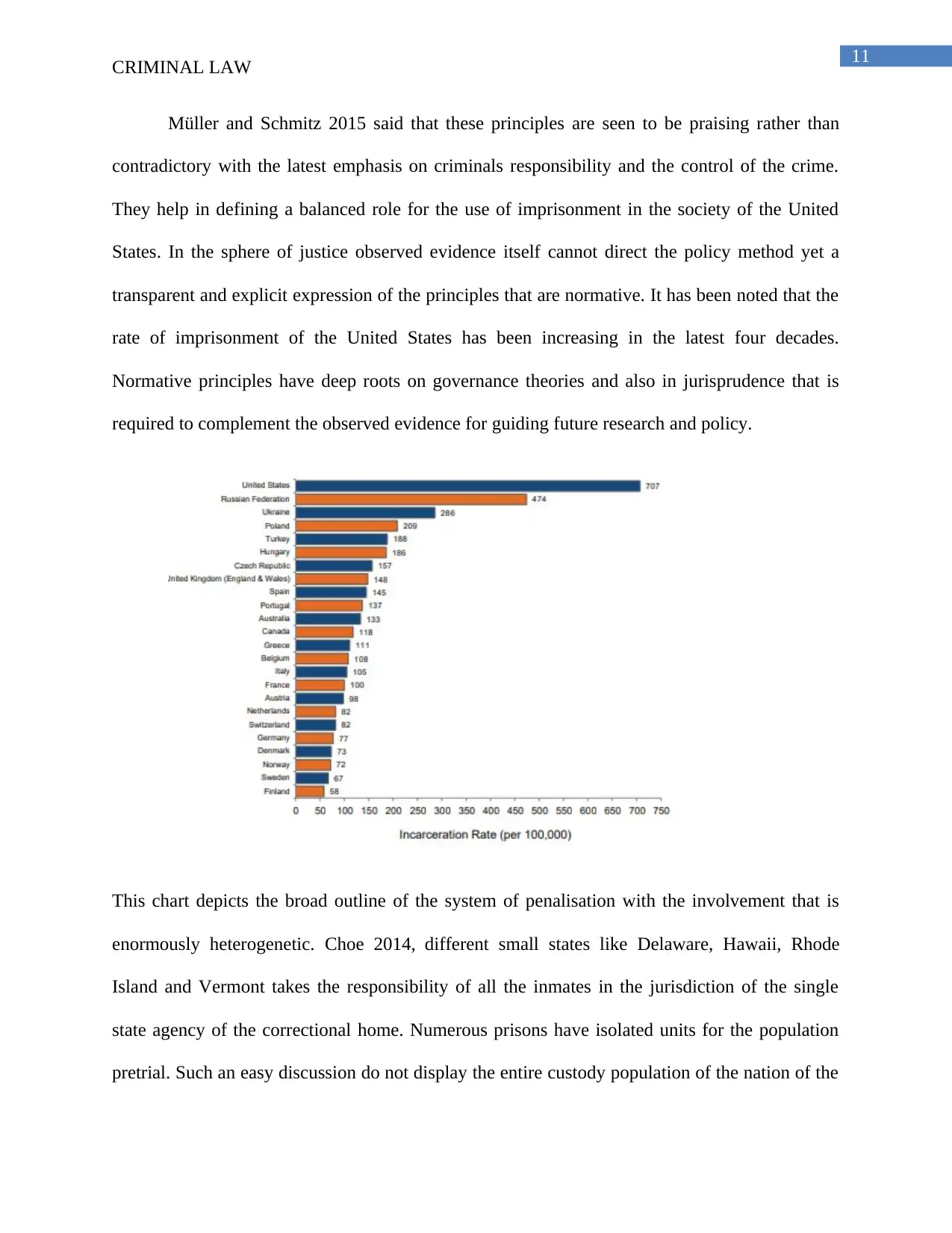
11
CRIMINAL LAW
Müller and Schmitz 2015 said that these principles are seen to be praising rather than
contradictory with the latest emphasis on criminals responsibility and the control of the crime.
They help in defining a balanced role for the use of imprisonment in the society of the United
States. In the sphere of justice observed evidence itself cannot direct the policy method yet a
transparent and explicit expression of the principles that are normative. It has been noted that the
rate of imprisonment of the United States has been increasing in the latest four decades.
Normative principles have deep roots on governance theories and also in jurisprudence that is
required to complement the observed evidence for guiding future research and policy.
This chart depicts the broad outline of the system of penalisation with the involvement that is
enormously heterogenetic. Choe 2014, different small states like Delaware, Hawaii, Rhode
Island and Vermont takes the responsibility of all the inmates in the jurisdiction of the single
state agency of the correctional home. Numerous prisons have isolated units for the population
pretrial. Such an easy discussion do not display the entire custody population of the nation of the
CRIMINAL LAW
Müller and Schmitz 2015 said that these principles are seen to be praising rather than
contradictory with the latest emphasis on criminals responsibility and the control of the crime.
They help in defining a balanced role for the use of imprisonment in the society of the United
States. In the sphere of justice observed evidence itself cannot direct the policy method yet a
transparent and explicit expression of the principles that are normative. It has been noted that the
rate of imprisonment of the United States has been increasing in the latest four decades.
Normative principles have deep roots on governance theories and also in jurisprudence that is
required to complement the observed evidence for guiding future research and policy.
This chart depicts the broad outline of the system of penalisation with the involvement that is
enormously heterogenetic. Choe 2014, different small states like Delaware, Hawaii, Rhode
Island and Vermont takes the responsibility of all the inmates in the jurisdiction of the single
state agency of the correctional home. Numerous prisons have isolated units for the population
pretrial. Such an easy discussion do not display the entire custody population of the nation of the
⊘ This is a preview!⊘
Do you want full access?
Subscribe today to unlock all pages.

Trusted by 1+ million students worldwide
1 out of 22
Related Documents
Your All-in-One AI-Powered Toolkit for Academic Success.
+13062052269
info@desklib.com
Available 24*7 on WhatsApp / Email
![[object Object]](/_next/static/media/star-bottom.7253800d.svg)
Unlock your academic potential
Copyright © 2020–2025 A2Z Services. All Rights Reserved. Developed and managed by ZUCOL.





